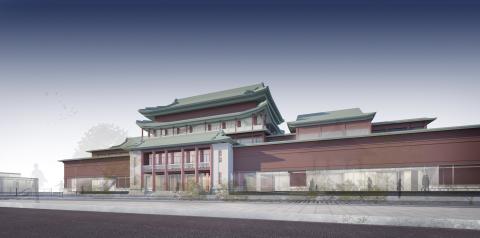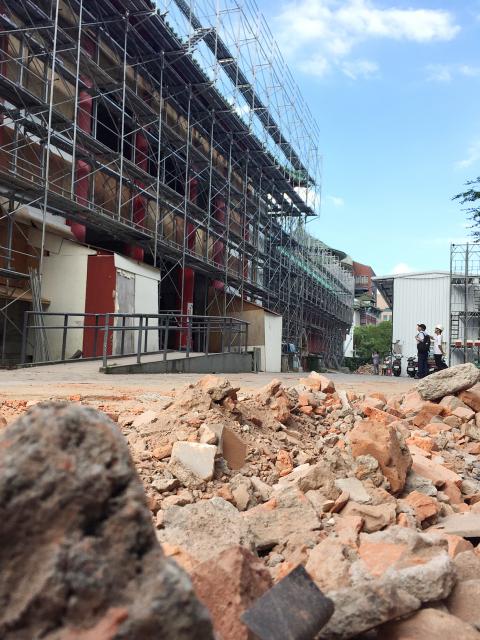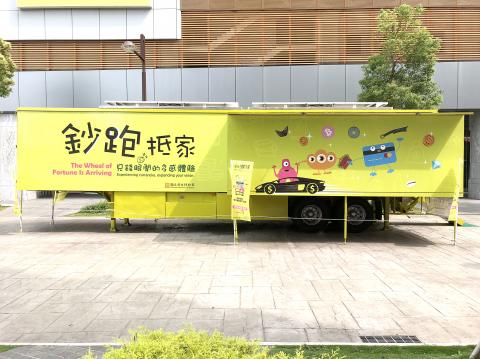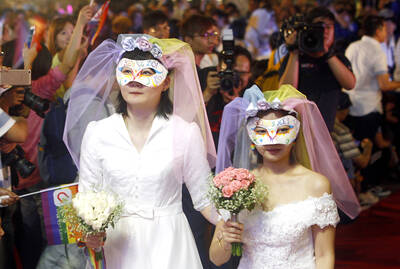In its 63 years, never before has the National Museum of History undergone such a large project. Staff anxiously crowded around a truck in July last year as the museum’s director sealed its doors in the first of 25 trips to move 63,000 artifacts, the entirety of the museum’s collection.
For three years, most of the pieces will sit in storehouses across the country, safe from vibration and dust as the museum undergoes badly needed renovations and excavators carve an MRT tunnel next door. It is a long time for a museum to be closed, but could be a boon for this institution that is eager to redefine itself.
“In the past, it was very much the cultural representation of the Republic of China, but after 63 years, everything is getting old, things change, people’s cultural tastes changed,” director Liao Hsin-tien (廖新田) told the Taipei Times.

Photo courtesy of the National Museum of History
Some visitors might come away from the museum a little confused about its vision. Its past charge as Chiang Kai-shek’s (蔣介石) bastion of Chinese culture has bequeathed treasured cultural artifacts, yet also a confusion of identity.
The museum was established after World War II as part of the Chinese Nationalist Party’s (KMT) “Nanhai cultural area” (南海學園), which aimed to Sinicize Taiwanese culture. Although Taiwan’s national identity has evolved, the museum is still tasked with pinning down the history its name promises, yet with largely the same collection.
The result has been disjointed, with Chinese artifacts presented separately from contemporary art exhibitions, a kind of portmanteau of the National Palace Museum and National Museum of Taiwan History in Tainan. Without having fully broken from this “Chinese Cultural Renaissance” (中華文化復興運動) past, it is slipping away from newer generations.

Photo: Kayleigh Madjar, Taipei Times
“We’ve found out that we can’t attract young people to our museum because of our collection, because of the way in which we express ourselves,” Liao said. “We want to connect with the young generation ... to express the message that in the future, when we open, this museum is for everyone.”
MOBILE MUSEUM
Across the country, a truck is parked near Yanfeng Elementary School in Nantou County, a cartoon face based on an ancient bronze stands smiling from the sides. Children clamber inside to solve puzzles and view 3D models of the piece that inspired the cartoon and other treasures from the museum’s collection.

Photo courtesy of the National Museum of History
The bright colors and energetic games are a departure from the image most people have of the institution, although this mobile museum and its partner have been traveling the country for 18 years, reaching 1.15 million children.
Previously a lesser known part of its programming, these trucks now represent the kind of interaction the museum hopes to foster.
“We are not a spider anymore. We are a bee,” Liao said. “We fly out and take pollen back and create honey, but a spider just waits there.”
Without its web, the museum has had to get more creative about how to spin connections.
Among other projects, it has created a mascot based on the cartoon bronze that the staff calls “Mr Cool,” and has been pushing image licensing and cultural industry collaboration in the hopes of freshening its image.
The staff is also venturing out to communicate with educators and other groups to see what they need and would actually use in order to create programming that would better serve the public.
Of course, the grand jewel of this rebranding will be the renovated museum itself, which is projected to open at the end of 2021.
MODERNIZED MUSEUM
With modernized amenities, thematic floors, a newly-dug international conference hall and more space with the staff and storage moved off site, Liao envisions a “kind of rebirth or metamorphosis” that can bring together the two parts of the museum’s collection.
“I want a permanent exhibition at the National Museum of History that can represent Taiwan. Not only Chinese culture, because we have different cultures,” he said, describing his hopes for the new third floor named after the massive collaborative painting Formosa Evergreen (寶島長春).
While the museum will still feature its treasured sancai (三彩, polychrome) pottery and bronzes, the plan is to place them alongside a carefully curated collection to provide a more comprehensive vision of Taiwan that includes Indigenous people, different genders, migrant groups and others who are also part of Taiwanese history.
“My mission is not to divide things, but to put things together. Not to mix them up, but connect things... Because this society has different cultures and we mix things together,” Liao said.
In the meantime, the museum’s artifacts will not entirely be hidden away in storage. To solve the practical issue of space and in the spirit of connection, the museum has partnered with various institutions, including the National Palace Museum and Academia Sinica, to conduct research and their own exhibitions.
Notably, the Henan bronzes can be viewed at Academia Sinica’s Institute of History and Philology until they are returned to the museum, while the new Tainan Art Museum is presenting Formosa Evergreen until Oct. 13. This year alone, the museum is holding 12 exhibitions at other institutions nationwide, while five are so far on the docket for next year.
Even after the museum itself reopens, part of it will have to wait even longer. Experts believe that artifacts are buried beneath the museum, a theory supported by finds workers are unearthing as they dig the new MRT line. The underground conference hall is expected to face similar delays as archeologists carry out excavation work, but Liao is excited to turn the delay into another opportunity.
“There will be some kind of living museum in front of our museum,” he said, laughing as he envisioned visitors peering over the side of a pit and watching archeologists at work.
The two guardian lions that flank the museum’s entrance — perhaps the only in the world to protect a national museum — will remain where they are during the renovation. The first director ordered them built after they appeared to him in a dream, promising to safeguard his museum. They now stand behind wooden boards, themselves protected from the construction happening around them.
Once revealed, the museum will highlight their story as part of a larger narrative about how many of its artifacts are rooted in the struggles over Taiwanese history. Yet the original mission they represent — “protectors of artifacts, promoters of culture” (文物的保護者, 文化的發揚者) — is to remain the same.

This month the government ordered a one-year block of Xiaohongshu (小紅書) or Rednote, a Chinese social media platform with more than 3 million users in Taiwan. The government pointed to widespread fraud activity on the platform, along with cybersecurity failures. Officials said that they had reached out to the company and asked it to change. However, they received no response. The pro-China parties, the Chinese Nationalist Party (KMT) and Taiwan People’s Party (TPP), immediately swung into action, denouncing the ban as an attack on free speech. This “free speech” claim was then echoed by the People’s Republic of China (PRC),

Exceptions to the rule are sometimes revealing. For a brief few years, there was an emerging ideological split between the Democratic Progressive Party (DPP) and Chinese Nationalist Party (KMT) that appeared to be pushing the DPP in a direction that would be considered more liberal, and the KMT more conservative. In the previous column, “The KMT-DPP’s bureaucrat-led developmental state” (Dec. 11, page 12), we examined how Taiwan’s democratic system developed, and how both the two main parties largely accepted a similar consensus on how Taiwan should be run domestically and did not split along the left-right lines more familiar in

Many people in Taiwan first learned about universal basic income (UBI) — the idea that the government should provide regular, no-strings-attached payments to each citizen — in 2019. While seeking the Democratic nomination for the 2020 US presidential election, Andrew Yang, a politician of Taiwanese descent, said that, if elected, he’d institute a UBI of US$1,000 per month to “get the economic boot off of people’s throats, allowing them to lift their heads up, breathe, and get excited for the future.” His campaign petered out, but the concept of UBI hasn’t gone away. Throughout the industrialized world, there are fears that

Most heroes are remembered for the battles they fought. Taiwan’s Black Bat Squadron is remembered for flying into Chinese airspace 838 times between 1953 and 1967, and for the 148 men whose sacrifice bought the intelligence that kept Taiwan secure. Two-thirds of the squadron died carrying out missions most people wouldn’t learn about for another 40 years. The squadron lost 15 aircraft and 148 crew members over those 14 years, making it the deadliest unit in Taiwan’s military history by casualty rate. They flew at night, often at low altitudes, straight into some of the most heavily defended airspace in Asia.